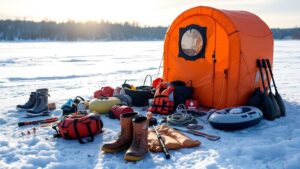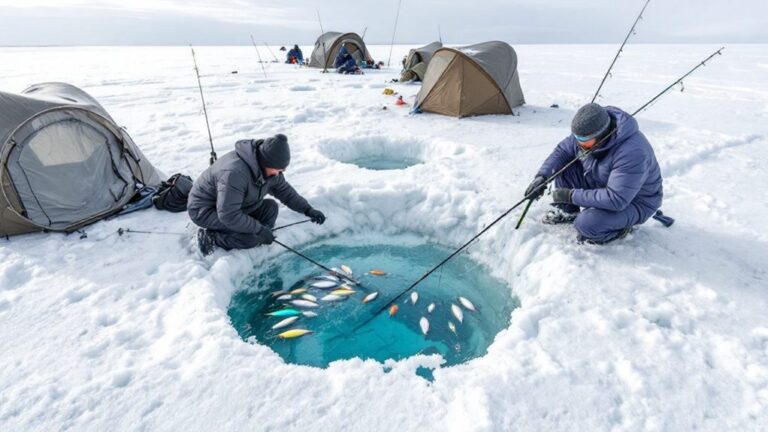For safe ice fishing, you'll need crucial gear that could save your life. Start with a floating ice suit and Coast Guard-approved personal flotation device, paired with ice picks worn around your neck for self-rescue. Carry a spud bar to test ice thickness (minimum 4 inches needed), and pack reliable communication devices like a charged cell phone and GPS unit. Don't forget cold-weather protection: thermal layers, insulated boots, and ice cleats for traction. A first aid kit, emergency shelter, and proper warming equipment round out your safety arsenal. These fundamentals just scratch the surface of what you'll need to master ice fishing safety.
Essential Flotation Safety Equipment
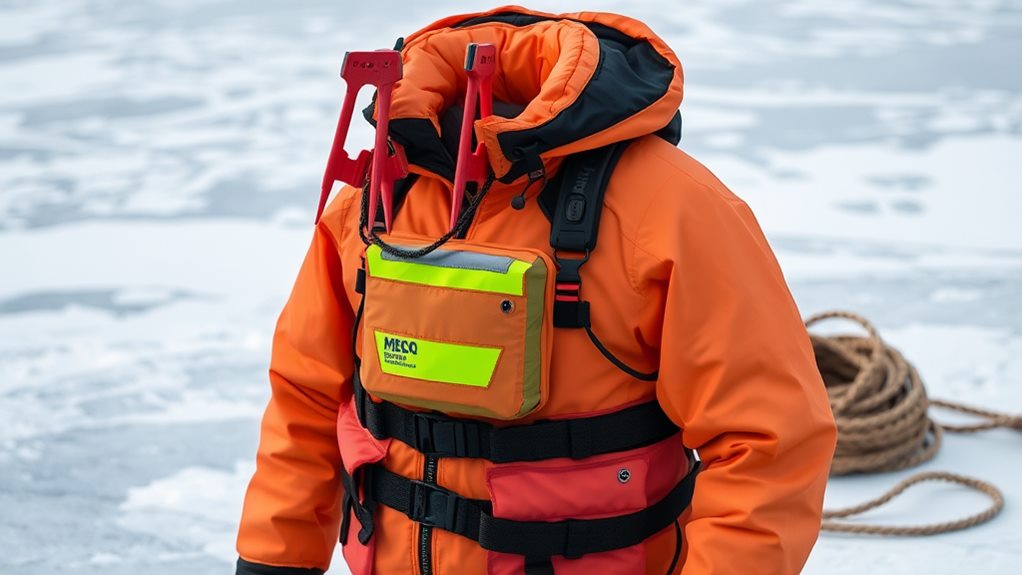
According to ice fishing experts, staying afloat in an emergency starts with proper flotation equipment. When you're out on the ice, you'll need multiple layers of protection to guarantee your safety, and that's where specialized flotation gear comes into play.
Your first line of defense should be a floating ice suit, which provides vital buoyancy while keeping you warm if you fall through the ice.
Don't forget to wear Coast Guard-approved personal flotation devices underneath – they're not just recommended, they're critical for survival in cold water emergencies.
Always keep ice picks hanging around your neck, as they'll help you pull yourself out if you break through the ice. Remember, they're only effective if they're readily accessible, so don't store them in your tackle box.
A throw rope rounds out your critical flotation safety gear. Make sure it's at least 50 feet long and easily accessible to anyone in your fishing party.
When combined with your other flotation gear, these items create a thorough safety system that greatly improves your chances of survival in an emergency situation.
Ice Testing and Assessment Tools
Before you step onto frozen water, you'll need reliable tools to verify that the ice can safely support your weight. Your primary ice fishing gear for safety assessment should include a spud bar, which lets you test ice integrity as you walk, and a reliable ruler or marked ice scoop to measure thickness accurately.
Remember that ice thickness requirements aren't negotiable – you'll need at least 4 inches of solid ice for safe foot travel. Don't rely on visual inspection alone; use your spud bar to check frequently, as thickness can vary considerably across the same body of water.
Keep these fundamental tools readily accessible:
- Spud bar or ice chisel
- Ruler or marked ice scoop
- Ice picks (worn around your neck for quick access)
Weather conditions play a key role in ice stability, so you'll want to monitor forecasts and temperature changes regularly. Your ice picks are critical for self-rescue if you break through, so make sure they're always within reach.
While it might seem like extra work to check ice thickness every few steps, it's far better than discovering weak spots the hard way.
Emergency Communication Devices
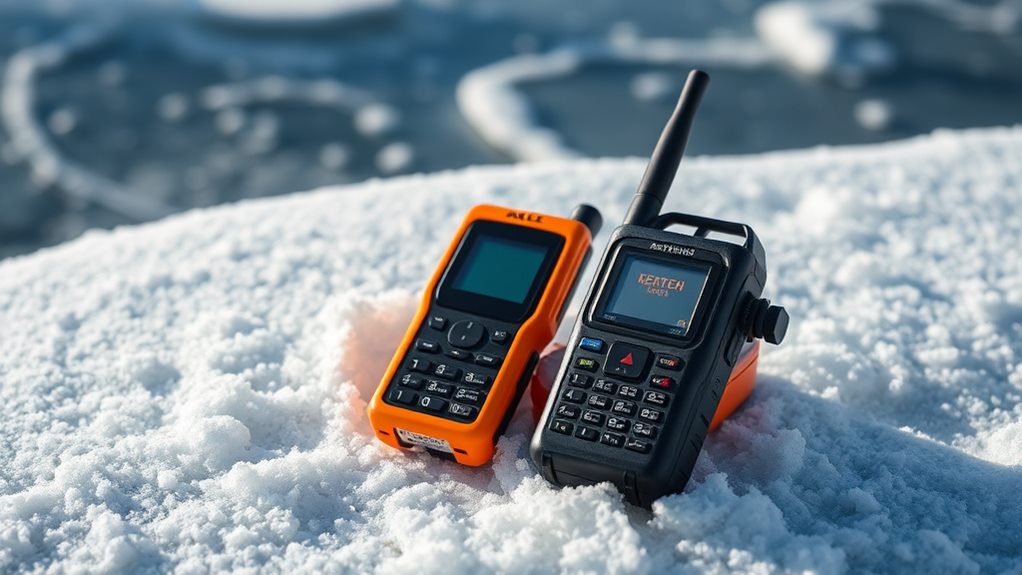
During emergencies on the ice, reliable communication devices can mean the difference between life and death. You'll want to pack several backup options to guarantee you're never caught without a way to call for help.
Your cell phone should be your first line of defense, but don't just toss it in your pocket. Keep it fully charged and secured in a moisture-proof bag to protect it from the elements.
Since cell service can be spotty in remote areas, you'll also want to carry a handheld VHF radio to communicate with nearby anglers or emergency responders.
For maximum safety, consider investing in a Personal Locator Beacon (PLB). These compact devices can transmit your exact GPS coordinates to rescue services if you're in serious trouble.
While you're at it, download the OnXmaps app on your smartphone – it's great for marking safe routes and avoiding dangerous areas.
Don't forget the basics, either. A simple whistle can be an excellent signaling device when your voice just isn't cutting it through the wind.
Cold Weather Protective Gear
Proper cold-weather gear serves as your primary defense against harsh winter conditions while ice fishing. When you're spending hours on the ice, your cold weather protective gear becomes an important safety consideration that you can't afford to overlook.
Start with quality thermal apparel as your foundation, choosing moisture-wicking base layers made from either polyester or merino wool. You'll want to master the art of layering clothing, which lets you adjust your comfort level as temperatures change throughout the day.
Add fleece-lined pants and insulated vests as your mid-layers, then top it off with specialized ice fishing suits that offer both windproofing and flotation features.
Don't forget these crucial accessories for extreme weather protection:
- Insulated boots that keep your feet warm and dry
- Balaclavas to shield your face from biting winds
- Neck warmers for additional protection
- Flip mitts that allow quick access to your fingers
Navigation and Location Equipment
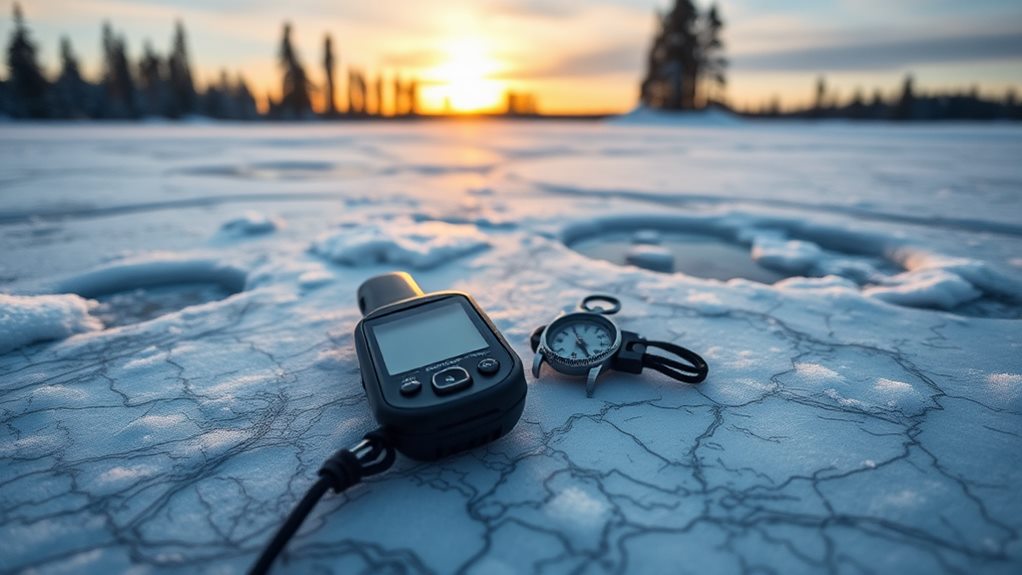
Modern navigation tools are your lifeline when venturing onto frozen lakes and waterways.
Today's ice anglers have access to various navigation aids that make exploring frozen waters safer and more efficient than ever before. From GPS devices that can be transferred between boats and ice fishing setups to smartphone apps like OnXmaps, you'll find plenty of options to keep you oriented.
When you're out on the ice, you'll want to rely on a combination of high-tech and traditional navigation tools.
Premium mapping solutions help you identify safe zones and potential hazards, while ice thickness measurement tools guarantee you're on stable ground. Don't forget to pack a reliable hand compass as a backup – it'll never run out of batteries when you need it most.
Here's what you should carry for safe navigation:
- A mounted GPS device for precise location tracking
- A smartphone with ice fishing navigation apps installed
- A traditional hand compass for emergency backup
- Ice thickness measurement tools like spud bars or chisels
With these navigation necessities in your gear bag, you'll be well-equipped to explore winter fishing spots while maintaining safety as your top priority.
First Aid and Survival Supplies
Equipped with navigation tools, you're halfway to a safe ice fishing experience – but life-saving first aid and survival gear is equally vital. Your first aid kit should contain basic medical supplies, while a portable emergency survival kit adds another layer of protection when you're out on the ice.
| Vital Item | Purpose |
|---|---|
| Thermal blanket | Prevents hypothermia |
| Personal locator beacons | Sends GPS distress signals |
| Throw bag with sturdy rope | Enables ice rescue |
Don't skimp on these critical items – they could mean the difference between a close call and a catastrophe. You'll want to pack plenty of hand warmers to keep your core temperature stable, and make certain your first aid kit includes antiseptic wipes, gauze pads, and adhesive bandages for treating minor injuries. A multipurpose tool in your survival kit can help you handle unexpected challenges, while a whistle and flashlight guarantee you can signal for help if needed.
Remember to check all your safety supplies before each trip, replacing any expired items and testing your personal locator beacons to verify they're functioning properly. After all, the best safety gear is the kind that works when you need it most.
Ice Traction and Mobility Aids
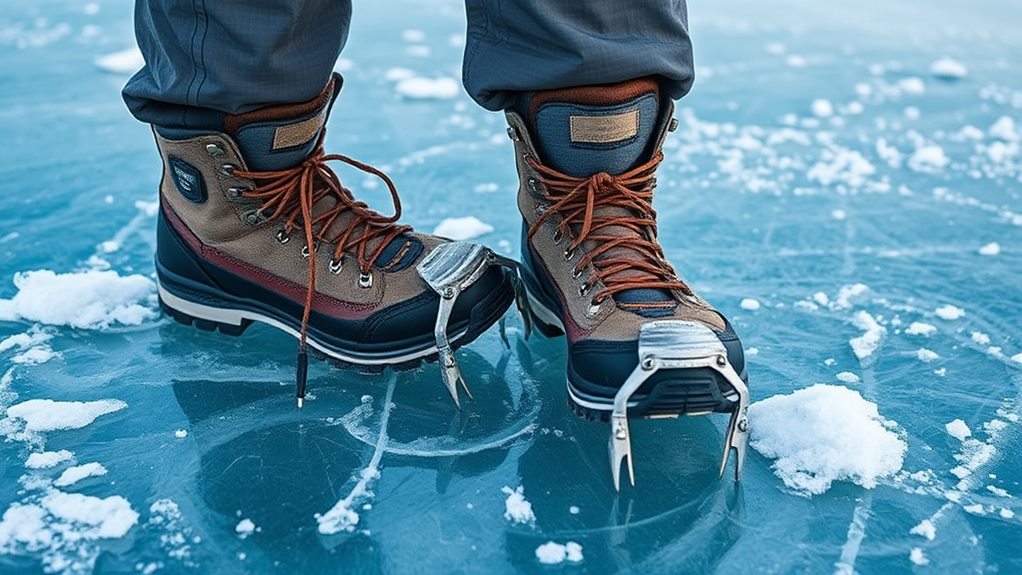
Safe movement across frozen lakes demands reliable traction and mobility equipment. When you're hauling your gear onto the ice, you'll need proper safety gear to prevent dangerous slips and falls.
Your vital ice traction and mobility aids should include ice cleats that attach to your boots, providing critical grip on slippery surfaces, and ice picks worn around your neck for emergency self-rescue situations.
Here's what you'll need for safe movement on the ice:
- Insulated boots with non-slip soles, which serve as your first line of defense against both cold and slick conditions.
- Ice cleats or creepers that attach to your boots, featuring metal spikes for enhanced traction on slippery surfaces.
- An ice chisel (spud bar) to test ice thickness as you move across the lake.
- Mobility aids like sleds or ice fishing carts to transport your equipment safely.
Shelter and Warming Solutions
Once you've secured your footing on the ice, protecting yourself from harsh winter elements becomes your next priority.
You'll need reliable shelter and warming solutions to stay safe and comfortable during your ice fishing adventure. Proper preparation is fundamental, as unpredictable weather can quickly turn a fun outing into a dangerous situation; this is why understanding ice fishing safety is crucial.
Portable shelters, including flip-over and hub styles, are critical pieces of safety equipment that provide essential wind protection and help retain heat.
These insulated shelters don't just keep you cozy – they're significant in preventing hypothermia and creating a stable environment where you can focus on fishing rather than fighting the cold.
When it comes to warming your shelter, portable propane heaters are your best friend, but they require careful attention to safety.
Always verify your heater has a low oxygen sensor, and don't even think about firing it up without a battery-powered carbon monoxide detector in place.
Think of these detectors as your silent guardians against invisible threats.
Pro tip: Look for shelters with multiple layers of insulation and sealed seams.
You'll be amazed at how much difference proper insulation makes in maintaining a comfortable temperature, which means you can stay out longer and potentially catch more fish.
Frequently Asked Questions
What Does Every Ice Fisherman Need?
You'll need ice picks around your neck, a floating ice suit for warmth, ice cleats for traction, an ice chisel to check thickness, and a first aid kit for emergencies while fishing.
What to Take on an Ice Fishing Trip?
You'll need ice picks, a floating suit, ice chisel, cleats, and a throw rope for safety. Don't forget your fishing rod, bait, auger, bucket, and portable shelter for a successful ice fishing trip.
How to Keep From Drowning While Ice Fishing?
You'll stay safe by wearing a Coast Guard-approved life jacket, carrying ice picks, and bringing a throw rope. Don't fish alone, and always check ice thickness before stepping out. Never take safety shortcuts.
What Do Ice Fishermen Wear Around Their Neck?
You'll want to wear ice safety picks around your neck when ice fishing. They're crucial for pulling yourself out if you fall through. Many anglers also attach a whistle for emergency signaling.
Final Thoughts
When you're heading out on the ice, you'll need more than just fishing gear to stay safe and comfortable. By following this safety equipment checklist and properly preparing for your ice fishing adventure, you'll considerably reduce risks while maximizing enjoyment. Remember, the right gear isn't just about comfort – it's about survival. Don't skimp on crucial safety equipment, as being prepared can make the difference between a great outing and a dangerous situation.

